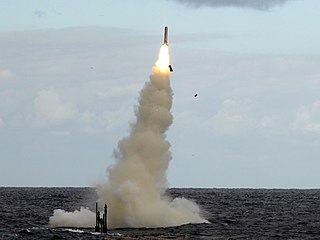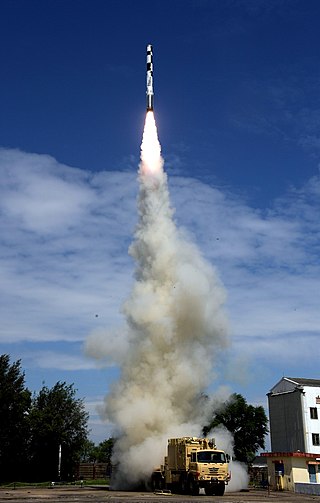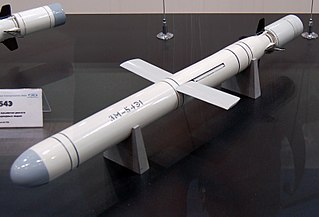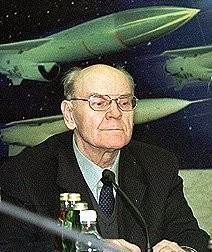Related Research Articles

A cruise missile is an unmanned self-propelled guided vehicle that sustains flight through aerodynamic lift for most of its flight path and whose primary mission is to place an ordnance or special payload on a target. Cruise missiles are designed to deliver a large warhead over long distances with high precision. Modern cruise missiles are capable of traveling at high subsonic, supersonic, or hypersonic speeds, are self-navigating, and are able to fly on a non-ballistic, extremely low-altitude trajectory.
The P-700 Granit is a Soviet and Russian naval anti-ship cruise missile. Its GRAU designation is 3M45, its NATO reporting name SS-N-19 Shipwreck. It comes in surface-to-surface and submarine-launched variants, and can also be used against ground targets.

A submarine-launched cruise missile (SLCM) is a cruise missile that is launched from a submarine. Current versions are typically standoff weapons known as land-attack cruise missiles (LACMs), which are used to attack predetermined land targets with conventional or nuclear payloads. Anti-ship cruise missiles (ASCMs) are also used, and some submarine-launched cruise missiles have variants for both functions.

The BrahMos is a medium-range ramjet supersonic cruise missile that can be launched from submarines, ships, fighter aircraft or TEL. It is a joint venture between the Indian Defence Research and Development Organisation (DRDO) and the Russian Federation's NPO Mashinostroyeniya, who together have formed BrahMos Aerospace. The missile is based on P-800 Oniks. The name BrahMos is a portmanteau formed from the names of two rivers, the Brahmaputra of India and the Moskva of Russia.

The Hsiung Feng III is a medium range supersonic missile with capabilities to destroy both land based targets and naval targets developed by the National Chung-Shan Institute of Science and Technology (NCSIST) in Taiwan.

The P-270 Moskit is a Soviet supersonic ramjet powered anti-ship cruise missile. Its GRAU designation is 3M80, air launched variant is the Kh-41 and its NATO reporting name is SS-N-22 Sunburn. The missile system was designed by the Raduga Design Bureau during the 1970s as a follow-up to the P-120 Malakhit. The Moskit was originally designed to be ship-launched, but variants have been adapted to be launched from land, underwater (submarines) and air, as well as on the Lun-class ekranoplan. The missile can carry conventional and nuclear warheads. The exact classification of the missile is unknown, with varying types reported. This uncertainty is due to the secrecy surrounding an active military weapon. The missile has been purchased and exported to the People's Liberation Army Navy (China) and Egyptian Navy (Egypt).

The P-800 Oniks, marketed in export as the Yakhont, is a Soviet / Russian supersonic anti-ship cruise missile developed by NPO Mashinostroyeniya as a ramjet version of P-80 Zubr. Its GRAU designation is 3M55, the air launched Kh-61 variant was planned but never built. The missile has the NATO codename SS-N-26 "Strobile". Development commenced in 1983, and in the 1990s the anti-ship missile was tested on the Project 1234.7 ship. In 2002 the missile passed the whole range of trials and was commissioned. It is reportedly a replacement for the P-270 Moskit, and possibly also of the P-700 Granit.

The Novator Kalibr, also referred to as 3M54-1 Kalibr, 3M14 Biryuza, is a family of Russian cruise missiles developed by NPO Novator (OKB-8). It first saw service in 1994. There are ship-launched, submarine-launched and air-launched versions of the missile, and variants for anti-ship, anti-submarine and land attack use. Some versions have a second propulsion stage that initiates a supersonic sprint in the terminal approach to the target, reducing the time that air defense systems have to react, while subsonic versions have greater range than the supersonic variants. The missile can carry a warhead weighing up to 500 kilograms (1,100 lb) of explosive or a thermonuclear warhead.
The Lockheed Martin BGM-178 RATTLRS was an advanced cruise missile concept demonstration funded by the US Navy with the view to develop technologies that would then be used to develop a successor to the BGM-109 Tomahawk. The five year contract was awarded on 1 March 2004. It is a possible solution to hypersonic cruise missile systems for the United States.

The YJ-12 is a Chinese supersonic anti-ship cruise missile.

The AV-TM 300 Tactical Missile or MTC-300 is a Brazilian cruise missile developed by Avibras for the Astros II system. Nicknamed Matador ("killer"), it is projected to be a less expensive alternative to the American BGM-109 Tomahawk. The missile is equipped with a central computer that combines a Ring laser gyroscope, connected to an active GPS navigation device that uninterruptedly supplies positioning information for course correction. Apparently there also will be a naval version called X-300. The missile can use a single warhead of 200 to 500 kg high explosive or cluster munition warhead with 64 submunitions for anti-personnel or anti-tank targets.

The BrahMos Aerospace is an Indo-Russian multinational aerospace and defense corporation, with core manufacturing concentrations in Cruise missiles. Headquartered in New Delhi, India, it was founded as a joint venture between the India's Defence Research and Development Organisation and NPO Mashinostroyenia of Russia. Company's name is a portmanteau formed from the names of two rivers, the Brahmaputra of India and the Moskva of Russia.

GerbertAleksandrovich Yefremov is a Soviet and Russian scientist, design engineer and Professor of Technical Sciences.
The Yun Feng, officially designated Ching Tien (雲峰), is a supersonic land-attack cruise missile of Taiwan.
BrahMos-II or BrahMos-2 or BrahMos Mark II is a hypersonic scramjet-propelled missile currently under joint development by India's Defence Research and Development Organisation and Russia's NPO Mashinostroyenia, which have together formed BrahMos Aerospace Private Limited. The BrahMos-II is expected to have a range of 1,500 kilometres and a speed of Mach 8. During the cruise stage of flight, the missile will be propelled by a scramjet airbreathing jet engine. Other details, including production cost and physical dimensions of the missile, are yet to be published.
The YJ-18 is a Chinese anti-ship cruise missile.
The P-900 Alfa П-900 3М51 Альфа Alfa AFM-L, GRAU designation 3M51, is an anti-ship missile developed from the 3M54 Kalibr, P-800 Oniks and P-700 Granit.
The 3M22 Zircon, also spelled as Tsirkon is a Russian scramjet-powered, nuclear-capable hypersonic cruise missile. Produced by NPO Mashinostroyeniya for the Russian Navy, the missile utilizes the ZS-14 launch platforms on frigates and submarines. The missile has a reported top speed of Mach 9. The weapon was first used during Russia's invasion of Ukraine.

HD-1 is a supersonic land-attack and anti-ship missile developed by Guangdong Hongda Mining Company. Unlike the similar CM-302, the HD-1 requires an add-on solid rocket booster.
References
- 1 2 3 4 Zhuhai Surprise: China’s Third “Russian” Supersonic ASCM - Aviationweek.com, 7 November 2014
- 1 2 3 4 For Sale: China’s Mach 3 Anti-Ship Missile - Nationalinterest.org, 2 December 2014
- 1 2 Origin of China’s Latest Cruise Missile Debated - Ainonline.com, 21 November 2014
- 1 2 3 4 China's CX-1 Missile Now Exportable Archived 9 December 2015 at the Library of Congress Web Archives - Defensenews.com, 30 November 2014